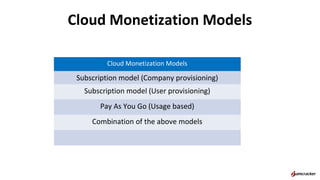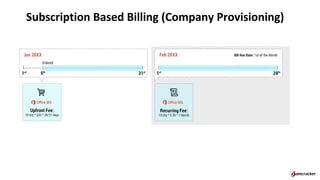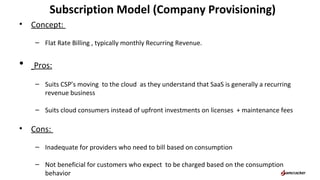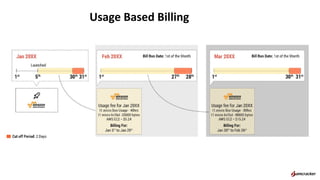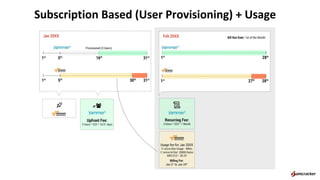Cloud Billing : Monetization Models | Subscription Based | Usage Based Billing Models for Cloud Service Providers
- 1. Cloud Billing - Monetization
- 2. Cloud Monetization Models Cloud Monetization Models Subscription model (Company provisioning) Subscription model (User provisioning) Pay As You Go (Usage based) Combination of the above models
- 3. Subscription Based Billing (Company Provisioning)
- 4. Subscription Model (Company Provisioning) ŌĆó Concept: ŌĆō Flat Rate Billing , typically monthly Recurring Revenue. ŌĆó Pros: ŌĆō Suits CSPŌĆÖs moving to the cloud as they understand that SaaS is generally a recurring revenue business ŌĆō Suits cloud consumers instead of upfront investments on licenses + maintenance fees ŌĆó Cons: ŌĆō Inadequate for providers who need to bill based on consumption ŌĆō Not beneficial for customers who expect to be charged based on the consumption behavior
- 5. Subscription Based Billing (User Provisioning)
- 6. Subscription Model (User Provisioning) ŌĆó Concept: ŌĆō Based on the actual number of users assigned to the SaaS service ŌĆó Pros: ŌĆō Enterprise benefit as billing starts when provisioned to individual users ŌĆō Model is reflective of the enterpriseŌĆÖs license pattern ŌĆó Cons: ŌĆō SaaS software entitlements need to be managed ŌĆō May not be useful to CSPs as it may result in loss of revenue when licenses are not assigned to enterprise users
- 8. Usage Based (PAYG) Model ŌĆó Concept: ŌĆō Based on the actual usage of the cloud service ŌĆó Pros: ŌĆō Pay only for the actual volume of resources consumed ŌĆō Possible to optimize and control cloud spend by governance ŌĆó Cons: ŌĆō Enterprises have difficulty in predicting the cloud expenses ŌĆō A bill shock likely without effective policy control and enforcement ŌĆō Metering the usage and providing granular details is complex for CSPs/Resellers
- 9. Subscription Based (Company Provisioning) + Usage
- 10. Subscription Based (User Provisioning) + Usage


